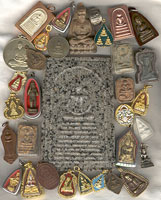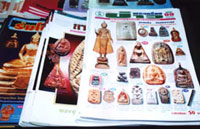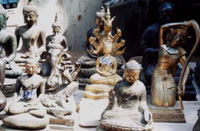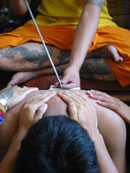Amulets
Buddhist amulets are popular among Thais and foreigners alike. Amulets are small images of Buddhist and Hindu deities cast in precious metals, clay, stone or other material and usually worn on a necklace. Different amulets are said to possess different powers. They can help attract the opposite sex, provide protection in battle or assist in good fortune.
Unless you are in a main shopping centre, price tags are an uncommon sight in Thailand. This is particularly true when it comes to amulets and Buddhist statues (except in major tourist areas). Thais view Buddha images not so much as works of art or objects of trade but rather as precious religious symbols to be treated with respect.
Once at a temple in Chiang Mai, a friend decided he wanted to acquire a small statue of the Lord Buddha. He was presented with papers to sign, which stated that he had obtained permission to permanently ‘rent’ the statue from the temple for a certain fee. I learned that the words ‘buy’ and ‘sell’ are not used when trading amulets or Buddhist statues.
‘sell’ are not used when trading amulets or Buddhist statues.
Amulets usually display a scene from the Lord Buddha’s life or commemorate Thailand’s most revered monks. Most people in Thailand wear at least one amulet, but some can be seen wearing over twenty. If a person performs a high-risk job (high-rise construction work, motorcycle or taxi driving), the more amulets they are likely to wear. Amulets give their wearers a sense of security and serve as a symbol of faith.
Although wearing an amulet is almost universally accepted in Thailand, it can be controversial among Buddhist scholars who point out that the wearing of amulets was never mentioned in the Buddhist Scriptures.
Amulet vendors are everywhere. On the side of the street, in parking lots, jewelry shops, at Buddhist temples, or near auspicious sites, the buying and selling of amulets is a popular and sometimes very expensive activity. The age, rarity, material and history of an amulet determine its worth. It is typical to see traders peering at amulets through magnifying glasses to determine their value. There are hundreds of magazines that cater to this hobby. The amulet market is flooded with fakes and making a ‘real find’ takes expertise.
worth. It is typical to see traders peering at amulets through magnifying glasses to determine their value. There are hundreds of magazines that cater to this hobby. The amulet market is flooded with fakes and making a ‘real find’ takes expertise.
Some amulets are given out for free at temples; others can be purchased for less that one-dollar while others soar into the hundreds of thousands. “The amulet market is considered one of the biggest in Thailand with sales in Bangkok alone worth more than 10 million baht a day.” (222,222 US Dollars) (Bangkok Post, March 2, 1999.)
Some amulets are true collectors items. Others, which are cast in gold and worn on a gold chain, can be turned in to a pawnshop when one needs to borrow money and be bought back at a later date (usually for a fee of ten percent of the total value).
Amulets, pictures of the Lord Buddha, or Buddhist statues should never be placed in a spot where people’s feet will be pointing at them. The way beds and chairs are arranged in a room help determine the correct area to place Buddhist images. It is respectful to keep Buddhist images on a high shelf with no other objects above them.
beds and chairs are arranged in a room help determine the correct area to place Buddhist images. It is respectful to keep Buddhist images on a high shelf with no other objects above them.
Thais will take offense if Buddhist images are not treated with respect but caring for Buddha images is not always as easy as it sounds. I had a photograph of a Buddhist statue I took enlarged and framed. I hung it high on the wall, above all other pictures and safe from pointing feet.
A Thai boy I know came over to visit and said, “Well, ummm, it is a very nice picture you have, but, ummm, I do not think I have ever seen a picture of the Lord Buddha in a bathroom before.” He knew I had good intentions and had made another accidental cultural blunder. Embarrassing!
The Amulet Market in Bangkok is a wonderful place to get an overview of this bustling trade and is nestled in a maze of small alleyways along the Chao Phraya River off of Maharat Road. The sheer quantity of amulets and statues available in these winding passages and small stores is mind-boggling. Fertility symbols, religious drawings, beads, jewelry and other ornamentation also clog the passageways.
I would recommend taking a stroll through this market but would warn that you will have to bargain hard. There is also no guarantee of purchasing a 200-year-old object although the vendors will try to convince you otherwise.
Permission must be obtained from the Department of Fine Arts if you wish to take any Buddhist images or antiques out of Thailand. Small Buddhist amulets can be taken out of the country without permission if they are to be used for religious purposes and hopefully be treated with care and respect.
